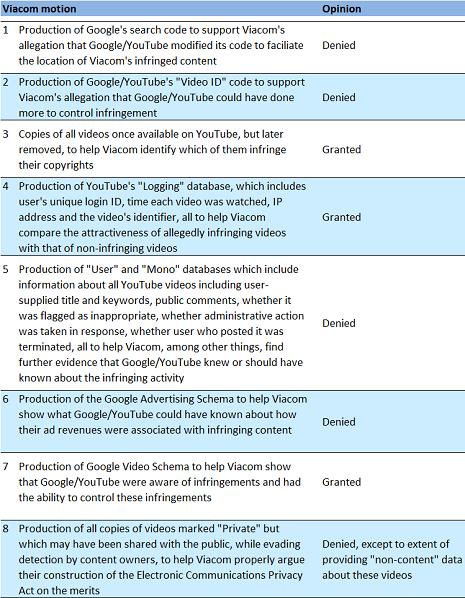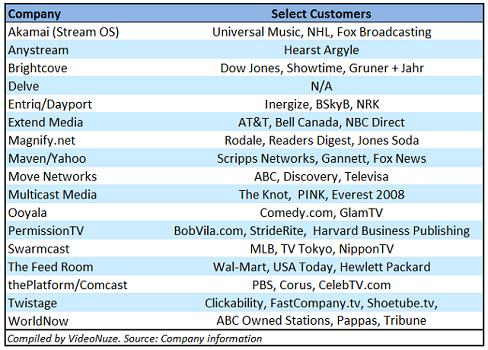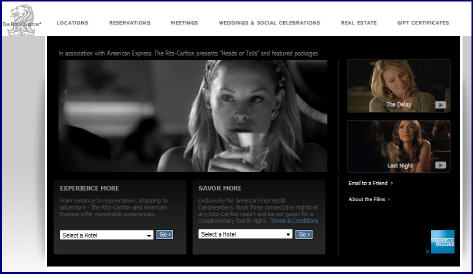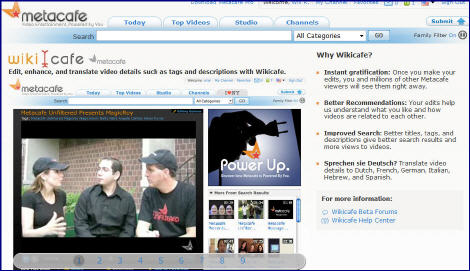-
Ritz-Carlton's Short Films: Sleek, But Successful?
A recent marketing campaign from Ritz-Carlton and American Express featuring three short original online films serves as a reminder to brands - and others - that even great content needs strong promotion for it to fully succeed. Let me explain.
Back in Nov '07, a long WSJ article entitled, "Ritz-Carlton Web Films Play Down its Ritzy Image" caught my eye. The article provided the backstory of the famed luxury hotelier Ritz-Carlton's innovative marketing gambit to pitch its brand to younger guests with three 10 minute films from hot young director Shyam Madiraju. The films were especially noteworthy because they portrayed younger guests in somewhat risque situations a clear break from Ritz's staid tradition.
At the time I remember thinking broadband was well-suited to Ritz's challenge; broadband would allow Ritz to go well beyond what it could convey in 30 second TV spots, not to mention print ads. By gaining such prominent coverage in the WSJ, the campaign was off to a very good start. (Whoever Ritz's PR firm was, they more than earned their keep that day!)
I made a mental note to keep an eye out for promotions for the films. Yet months passed and I never saw any. While I'll readily concede I may have missed them, if I was looking for them and didn't see them, that suggests a pretty low likelihood that people who weren't on the lookout saw them. The WSJ article had indicated that the films would be promoted on Yahoo, MSN, YouTube, all sites I frequent, yet I never saw any promotions there. I also expected email notifications, given that I've stayed at Ritz locations and they no doubt had my email address (and if they didn't, Marriott, which owns Ritz, and where I've stayed repeatedly, certainly does). In addition, I've been an Amex cardholder for years and I get promotions from them all the time.
I finally received my first email a couple of weeks ago with the subject line "The Ritz-Carlton Films presents 'Heads or Tails' and Exclusive Offers." This was the third of the three short films, which debuted on June 1st. I clicked through watched it (and the previous two) and thought they were all expertly done. They were sleek and provocative, luxuriously set at Ritz properties and subtly incorporated the Amex card in each. I found a few nits (e.g. why no full screen option?), but from the standpoint of conveying a hipper image while not alienating traditional guests, I think the films all hit the mark.
So from a content perspective, it looks like Ritz succeeded. My concern is whether a lot of people were exposed to the campaign and actually saw the films. I don't have the data to back this up, but my "experience of one" suggests that Ritz's promotional efforts were under-powered. I'm not that surprised; given this is new territory for brands as they essentially try to figure out how to "market a marketing campaign."
My advice is for brands to heed what Hollywood learned a long time ago: even great films and TV programs need great marketing to match (a recent example is the marketing blitz AMC is putting behind the premiere of "Mad Men" for its upcoming second season). As brands like Ritz create their own films and branded entertainment experiences, they need to remember that producing compelling content is just the starting point of accomplishing their marketing objectives.
What do you think? Post a comment now!
Categories: Brand Marketing
Topics: AMC, American Express, Marriott, Ritz-Carlton
-
Metacafe's New Wikicafe Refines Metadata Process
Metacafe, the short-form video aggregator with 30 million monthly visitors, has unveiled a new feature called "Wikicafe" which addresses the daunting and ongoing problem of how to find exactly the video you're looking for and gain high-quality recommendations.
Now in beta and available to its registered users only, Wikicafe is philisophically similar to Wikipedia, which involves users in building the knowledge base around specific content. Similarly, Wikicafe's goal is to involve users in continually refining the metadata for specific videos. This in turn will yield improved search and discovery for subsequent users.
Wikicafe is an intriguing spin on video search which I have discussed a number of times. Last week I spoke to Eyal Hertzog, Metacafe's co-founder and now chief creative officer, who's leading the charge on Wikicafe. This was the first briefing Metacafe has given on the new Wikicafe feature.
Eyal notes that there are really two ways to tackle content navigation. One is through super-sophisticated algorithms and distributed hardware, an approach epitomized by Google. The other is community-based collaboration, an approach epitomized by Wikipedia. He is biased toward the latter because he believes that the likelihood that the original metadata assigned by the video's creator (and even subsequent metadata that may be produced by technology-based approaches) will never be as accurate as that which is produced by other humans with specific domain knowledge.
Thus the idea behind Wikicafe: if given the right tools, Metacafe's users will create and maintain the most accurate metadata for Metacafe's vast collection of videos. It's a classic "wisdom of crowds" approach. Of course, it also requires that users act appropriately or things could spin out of control very quickly.
Wikicafe is very straightforward to use. Once logged in, you simply click on "Editing Options" in the upper right corner of each video. Then you can start editing the video's title, tags, description and then save your changes. You can track your changes (and those that others add), be notified about subsequent changes and start a discussion about your changes. You can even translate your changes into other languages. As Eyal explains it, this "collaborative taxonomy" allows redirection between related terms ("PS3" and "Playstation3"), clarifies ambiguous words, resolves hierarchical terms and connects different languages.
In a sense, Wikicafe is a natural evolution for Metacafe, which has always emphasized community involvement in filtering which content gets added and promoted on the site. With a group of active, passionate users and Wikipedia as a model, it seems likely that Wikicafe will gain traction in the community.
What then becomes especially intriguing is the potential for carrying the Wikicafe approach outside of Metacafe's borders for the larger universe of broadband video. Could users eventually become an augment or even replacement to top-down driven video guides, the norm in today's cable and satellite offerings? It's an interesting vision to contemplate. First let's see how Wikicafe evolves in the Metacafe community.
What do you think? Post a comment now!
Categories: Aggregators, Technology, Video Search
Topics: Google, MetaCafe, Wikipedia
-
Viacom - Google/YouTube Litigation Moves Into Slippery Territory
If you were off the grid last week celebrating the July 4th holiday, there were some important fireworks in the ongoing Viacom - Google/YouTube litigation well worth paying attention to.
Judge Louis Stanton of the US District Court in New York, who is presiding over the litigation, handed down an opinion that granted and denied some of what each party was requesting. The opinion is here. I have read it and below is my synopsis (remember I'm not a lawyer):

The fourth item is the one that has gained the most attention and controversy. Privacy advocates are ballistic that this is a violation of users' privacy rights. Specifically they have cited Judge Stanton's characterization of Google/YouTube's objection to this particular Viacom request on the basis of privacy concerns as "speculative." A cottage industry of ridicule has broken out across the blogosphere regarding whether the 80 year-old Judge Stanton is sufficiently tech literate to grasp online privacy concerns. Many believe Viacom will use the data to sue individual users for viewing pirated copies of Viacom's programs on YouTube.
Like everyone else, I'm concerned about privacy here as well and recognize that Judge Stanton has moved this case into some very slippery territory. Yet, at a higher level, I'm feeling some resentment toward Google and YouTube, especially given its famous "do no evil" mantra. There is no question that they knew pirated versions of key Viacom (and other) programs were showing up on YouTube, yet at the time months went by without them candidly addressing the issue and doing something sufficiently proactive about it. To many, including me, the standoff then was (and continues to be) a high-stakes battle between two multi-billion dollar companies jockeying for negotiating leverage.
When we use various web sites (whether for broadband or other uses), there is an implicit and explicit understanding that our privacy will not be trifled with. Sites have a right to defend their business practices based on their interpretation of the existing laws, but they need to be balanced by what impact their actions may ultimately have for their users. Each of us has our own interpretation of whether Google/YouTube should have done more to protect Viacom's and others' copyrights, but as Judge Stanton's decision shows, to what extent YouTube's users' privacy is protected is now entirely up to his interpretation.
What do you think? Post a comment and let everyone know!
Categories: Cable Networks, Video Sharing
Topics: Google, Viacom, YouTube
-
Happy July 4th
I'm giving the keyboard a rest for a few days to celebrate the long July 4th weekend. I'll see you on Monday, July 7th. Enjoy!
Categories: Miscellaneous
-
Ralph Lauren's Broadband Mini-Site Supports Brand, Drives Sales
Ralph Lauren is the latest brand to harness broadband video as part of its marketing mix.
I discovered the company's lush "Sports of Summer" mini-site after noticing the same rich media skyscraper ad in the NYTimes.com's Wimbledon coverage. Clicking through brings you to the Lauren mini-site, which highlights 4 sports that Lauren is sponsoring this summer: Wimbledon, The Olympics, the US Open (tennis) and the Black Watch polo team. On closer inspection, I noticed that the mini-site has actually just become the main part of the regular Lauren web site.
The structure of the mini-site is consistent across the four sports with each containing both video and text/photo content. At the bottom are three panels offering a rotating choice of content, which when clicked play in the large center section of the page. The content includes interviews, old highlights reels and other sport-related information. The content is drawn from RL magazine, a quarterly the company puts out, and also from RLTV, which is a series of celebrity interviews, fashion show footage, sports, commercials and other video.
Broadband is particularly powerful for Lauren because the company's marketing strategy has always been focused on immersing customers in the highly-aspirational Lauren lifestyle. Lauren has been masterful at conveying those attributes through print ads. Broadband takes it to the next level. For example, when you click on the Wimbledon tab and see the very 1920's British-looking Lauren models frolicking to classical music (what is that piece?!), you really get the full impact of the brand's sensibilities. That the same 30 second piece plays over and over again however is a drawback; it would have been nice if Lauren had created at least 2 or 3 others to break the repetition....
Still, the point is that the broadband-centric mini-site lets Lauren go beyond what it ordinarily would have been able to do with TV ads, and surely at a fraction of the cost. By embedding the mini-site in the navigation of the regular Lauren web site, you can easily access the product catalog for all-important shopping. So thought of another way, the ad on NYTimes.com and the mini-site content are really just ways of setting the stage and driving traffic to the site for users to buy products. While most e-commerce companies might be running online ads blurting "SALE!" to drive traffic, Lauren's more subtle approach is in keeping with its brand image.
Broadband is opening up a whole new lever for brands to experiment with. I expect we'll continue to see a lot more activity from them. If you know of some good examples, send them along!
Categories: Brand Marketing
Topics: Ralph Lauren
-
June '08 VideoNuze Recap - 3 Key Topics
Wrapping up a busy June, I'd like to quickly recap 3 key topics covered in VideoNuze:
1. Execution matters as much as strategy
I've been mindful since the launch of VideoNuze to not just focus on big strategic shifts in the industry, but also on the important role of execution. I'm not planning to get too far into the tactical weeds, but I do intend to show examples where possible of how successful execution can make a difference. This month, in 2 posts comparing and contrasting Hulu and Fancast (here and here) I tried to constructively show how a nimble upstart can get a toehold against an entrenched incumbent by getting things right.
While great execution is a key to successful online businesses, it may sometimes feel pretty mundane. For example, in "Jacob's Pillow Uses Video to Enhance Customer Experience" I shared an example of an arts organization has begun including video samples of upcoming performances on its web site, improving the user experience and no doubt enhancing ticket sales. A small touch with a big reward. And in this post about the analytics firm Visible Measures, I tried to explain how rigorous tracking can enhance programming and product decisions. I'll continue to find examples of where execution has had an impact, whether positive or negative.
2. Cable TV industry impacted by broadband
As many of you know, I believe the cable TV industry is a crucial element of the broadband video industry. Cable operators now provide tens of millions of consumer broadband connections. And cable networks have become active in delivering their programs and clips via broadband. Yet the broadband's relationships with operators and networks are complex, presenting a range of opportunities and challenges.
On the opportunities side, in "Cable's Subscriber Fees Matter, A Lot," I explained how the monthly sub fees that networks collect put them on a firm financial footing for weathering broadband's changes and an advantageous position compared to broadband content startups which must survive solely on ads. Further, syndication is offering new distribution opportunities, as evidenced by Scripps Networks syndication deal with AOL in May and Comedy Central's syndication of Daily Show and Colbert Report to Hulu and Adobe. Yet cable networks are challenged to exploit broadband's new opportunities while not antagonizing their traditional distributors.
For operators, though broadband access provides billions in monthly revenues, broadband is ultimately going to challenge their traditional video subscription business. In "Video Aggregators Have Raised $366+ Million to Date," I itemized the torrent of money that's flowed into the broadband aggregation space, with players ultimately vying for a piece of cable's aggregation revenue. These and other companies are working hard to change the video industry's value chain. There will be a lot more news from them yet to come.
3. Video publishing/management platforms continue to evolve
Lastly, I continued covering the all-important video content publishing/management platform space this month, with product updates from PermissionTV, Brightcove and Entriq/Dayport. Yesterday, in introducing Delve Networks, another new player, I included a chart of all the companies in this space. I put a significant emphasis on this area because it is a key building block to making the broadband video industry work.
These companies are jostling with each other to provide the tools that content providers need to deliver and optimize the broadband experience. The competitive dynamic between these companies is very blurry though, with each emphasizing different features and capabilities. Nonetheless, each seems to be winning a share of the expanding market. I'll continue covering this segment of the industry as it evolves.
That's it for June; I have lots more good stuff planned for July!
Categories: Aggregators, Cable Networks, Cable TV Operators, Technology
Topics: AOL, Brightcove, Comedy Central, Delve, Entriq, Fancast, Hulu, Jacobs Pillow, PermissionTV, Scripps, Visible Measures
-
Delve is Latest Entrant in Video Platform Space
A couple of weeks ago, Delve Networks, a company formerly known as Plugg'd, which had focused on podcasting, announced that it was switching gears to jump into the video content management/platform space. I have long thought that this area was pretty crowded, so I was interested to learn from Delve's CEO/founder Alex Castro, what he believes makes Delve different and how it can win business vs. more established players.
Just to give a sense of who's already playing in this market, here's a quick overview (apologies to anyone I've left out...):

Alex described two principal ways that Delve is going to try to distinguish itself. The first is by enabling its customers to provide an improved user experience. The key to this is Delve's proprietary technology that allows users to see the most relevant part of a video stream. Delve uses both speech recognition and semantic approaches to create a "heat map" (see demo) above the video controls, indicating the most relevant segments to viewers. Of course speech recognition and accompanying techniques are used by Digitalsmiths, EveryZing, ScanScout and others to enhance discovery. I asked Alex about these and he contended that nobody has yet pulled these technologies into a comprehensive product.
Alex believes Delve's other differentiator is its user interface and workflow tools for content producers. Alex pointed to market research that Delve commissioned, which he said showed dissatisfaction with competitors' tools. He thought this was surprising given how long other players have been in the market and how much money has been invested to date. He sees the subpar results as creating opportunity for Delve.
In addition to the producer side, he thinks the consumer side UI of video is also an area in need of improvement. In addition to improved discovery, he cited the so-called "video ghettos" created by dedicated video player/channel environments. Note this an area Brightcove is looking to re-cast as well through its recent Brightcove3 beta release. (Alex is pretty blunt in his assessment of Brightcove; some thoughts are here on his blog)
All of this leads Alex and the Delve team to think that it's still very early in the broadband video industry's evolution with much opportunity still out there. Yet I suggested that most major media companies have long since done their due diligence and begun standardizing on certain platforms. Somewhat agreeing, Alex maintained that Delve has a full pipeline of remaining major media companies who have been mostly experimenting to date, plus a large assortment of non-traditional video publishers and smaller players all taking meetings with Delve.
Of course Alex is right that it is still early in the grand scheme of things and few would consider their current platform decisions fully locked in. But the question for Delve remains whether it can truly capitalize on the above differentiators while also being competitive on the full range of other features incumbents now offer. It will be interesting to watch what happens, especially with Alex's colorful commentary along the way.
What do you think? Post a comment now!(Note: Swarmcast and Magnify.net were inadvertently omitted from the original chart above.)
-
The Incredibly Growing YouTube
Closing out the week, I missed this blurb from Information Week yesterday reporting YouTube's staggering dominance of broadband video traffic. New numbers out from Hitwise show that in May '08 YouTube garnered 75% of the 10 million visits to 63 video sites that Hitwise is tracking. That's 9 times the traffic of #2 MySpaceTV and more than 20 times that of the #3 site which is Google's other video property (remember it?)
According to Hitwise YouTube's share rose 26% from a year ago compared with drops by all the others in the top 5 sites except Veoh, which rose by 32% from a year ago.
It's just mind-boggling to think that one site could have such market share, particularly when a lot of the
 networks' programs cannot be found there. I think it speaks to how strong users' appetites are for UGC and viral content remain, how YouTube has become a de facto video platform for lots of smaller players in the industry (and consumers) and how the company is likely beginning to enjoy some early success with its partners' channels.
networks' programs cannot be found there. I think it speaks to how strong users' appetites are for UGC and viral content remain, how YouTube has become a de facto video platform for lots of smaller players in the industry (and consumers) and how the company is likely beginning to enjoy some early success with its partners' channels. A few months ago, in "YouTube: Over-the-Top's Best Friend" I wrote that YouTube is quickly becoming the perfect ally for all those makers of new broadband-to-the-TV devices. These companies desperately need content and credible brands to help pull through consumer demand. YouTube offers both. In this sense, YouTube has huge value yet to be tapped (of course demonstrating that it can monetize its massive audience wouldn't hurt its partnership value...)
However, looked at another way, YouTube's success should be very encouraging to other players. To start with, YouTube is doing a marvelous job educating the world about the virtues of broadband video. And while YouTube is the market's 800 pound gorilla, it is still leaving key opportunities open for other players to differentiate themselves. Potential areas include high-quality delivery, ad-based and paid monetization and offering content that YouTube simply doesn't have (examples: Comedy Central programs like "The Daily Show" and "Colbert Report")
Volumes are yet to be written about YouTube. Whether it turns its market-leading traffic into a financially-explosive franchise or forever remains a red-ink spewing blip on Google's P&L is yet to be seen. Either way, when the history of broadband video is written, YouTube will be featured prominently.
Categories: Aggregators, UGC, Video Sharing
Topics: Comedy Central, Hitwise, MySpaceTV, Veoh, YouTube





